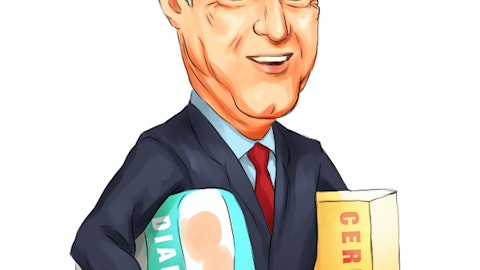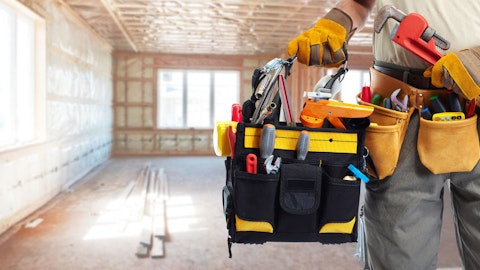We went and expanded our business by buying CornellCookson. So between Clopay, CornellCookson and the brands that we have, Clopay and Ideal, we have become the leader in both residential and in commercial. The growth in both businesses, which we said five years ago, we saw the pivot on the commercial business as being both a way for us to grow and diversify. And we always understood that it was going to be – something that was going to be a margin-enhancing. We went through COVID, we positioned the company to be not just able to get through, but to continue to gain market share. So the margin improvement story has been happening over a very long period of time. It’s now at a level that we believe we’re in an elite class of manufacturers. We don’t necessarily get value that way in the public market, and we’ve been taking advantage of it.
We think this is a very valuable business. We think its growth is still in front of it on the commercial side. The residential side continues to be strong for us. Our dealer network, our big box positioning makes us the leader in the space. And we expect to gain market share and maintain our margins going forward.
Operator: Our next question comes from Tim Wojs from Baird. Please proceed.
Tim Wojs: Hi, guys. Good morning. Nice job.
Brian Harris: Thank you. Good morning. how’re you doing, Tim?
Tim Wojs: I’m well, thanks. Maybe just on CPP. Just kind of curious how we should think about – I know you gave guidance for fiscal ’24, and you expect EBITDA to be a little bit above this past year. But how would you kind of think of the cadence there, Brian? And then trying to really kind of dive into like what the exit rate kind of looks like as you think about fiscal ’25. Just how we should kind of sequence the margin improvement at CPP over the next couple of years?
Brian Harris: Sure. So in the first half of ’24, we expect to be behind the first half of ’23 as inventory levels remain high at our customers and the consumer remains soft. In the second half, we expect – we have in our numbers the benefit of normalized weather. It’s hard to expect weather otherwise. And some benefits from the global sourcing expansion initiative will begin as we get into the second half of ’24. Exiting ’24, we expect inventory levels to be at a more normalized level at our customers and entering into ’25, we will selling sourced material opposed to the manufactured material, which we’ll be selling in ’24. As we get through ’25, we expect to be exiting ’25 at a 15% run rate and 2026 fully there.
Tim Wojs: Okay. Okay. That’s very helpful. And then I guess just on the cash side of things, you guys have been really good on the capital deployment. How are you thinking about buybacks through fiscal ’24? Just – you’ve been pretty active here the last few quarters. Is it fair for us to expect that to continue through the year?
Ron Kramer: We continue to believe our stock is a compelling value and we’ll take advantage of it.
Operator: Our next question comes from Julio Romero from Sidoti & Co. Please proceed.
Julio Romero: Hi, good morning, guys.
Brian Harris: Good morning.
Julio Romero: Good morning. On Home and Building Products, I appreciate the revenue kind of guidance you guys gave for both segments. There’s a 3% to 5% expected sales decline for HBP kind of embed any price degradation there? And just maybe speak to how price is holding up within the segment.
Brian Harris: Sure. It does not assume any price degradation, price is holding up well. The marketplace is disciplined and is led by four large players.
Julio Romero: Okay. That’s helpful. And then just – you guys talked about the CPP and how global sourcing is doing there. Maybe just talk about the competitive landscape within the channels that CPP sells into, specifically the larger ones of repair remodel of retail and international and maybe just talk about how each channel is doing, if you could.
Brian Harris: Sure. Australia. I’ll just start with Australia is continuing to perform very well. Canada continues to perform well. Those marketplaces are seeing reasonably good demand. The U.S. and the U.K. are in the same bucket where there’s higher inventory levels and the consumer is soft. In the U.K., they haven’t lost any market share. Recovery is just a matter of time. They’re already an asset-light model. And in the U.S., we are transitioning to the asset-light model, which will help our margins going forward. And we continue to serve the Pro with high-quality products, that are sought after by them, and that will continue.
Operator: Our next question comes from Sam Darkatsh from Raymond James. Please proceed.
Sam Darkatsh: Good morning, Ron. Good morning, Brian. How’re you?
Brian Harris: Well. How’re you Sam?
Sam Darkatsh: I’m well as well. Thanks for asking. I’ve got a bunch of questions, but I’ll be mindful of time and maybe I’ll get back into the queue. First one, I wanted to clarify maybe a rephrase question Tim asked earlier. Brian, the $103 million interest expense guidance for fiscal ’24, how much repo does that specifically assume beyond what you’ve already done in October here?
Brian Harris: It does not assume additional repurchases. But keep in mind, we expect free cash flow to cover repurchases.
Sam Darkatsh: Got you. And then as it relates to your free cash flow guide for next year being in excess of net income. First, does that include or exclude the perspective asset sales from CPP. And then related the $70 million in CapEx, is that the new normal run rate going forward? Or is that a continuation of some of the outsized CapEx that we’re seeing until end of this year?



